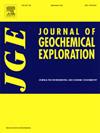Petrogenesis, tectonic setting and metallogenic potential of the Late Paleozoic and Late Mesozoic granitoids in the Central Great Xing'an Range, NE China
IF 3.4
2区 地球科学
Q1 GEOCHEMISTRY & GEOPHYSICS
引用次数: 0
Abstract
Granitoids are widely distributed throughout the Central Great Xing'an Range (CGXR). Determining their emplacement timing and stages is essential for reconstructing the tectonic and magmatic evolution of northeastern China. This study integrates geochemical, isotopic, and geochronological analyses of the Jalaid Banner-Zhalantun pluton to constrain its magma sources, petrogenesis, and tectonic setting, while investigating the link between magmatism and Cu-Mo-Au mineralization. Geochronological data indicate that the CGXR are predominantly composed of Late Carboniferous–Early Permian and Early Cretaceous (early and late stage) granitoids. Geochemical analyses reveal that the Late Carboniferous–Early Permian granites are highly to moderately fractionated I-type, characteristic of typical continental arc magmatic rocks. The early Early Cretaceous granites are classified as adakites, resulting from partial melting of newly thickened lower crust, whereas the late Early Cretaceous granite porphyry is classified as A1-type granite, with its primary magma likely derived from partial melting of juvenile crustal rocks under low-pressure conditions. Integrating the geochronological, geochemical, and Hf isotope data of Late Paleozoic and Late Mesozoic granitoids, we propose that the collision orogenic time between Xing'an block and Songliao block in the CGXR is not later than the Late Carboniferous–Early Permian. Since the earliest Cretaceous, the Paleo-Pacific Ocean regime became the predominant geodynamic control in NE China, with the superposition of Mongolia-Okhotsk Ocean regime also playing a role during the early Early Cretaceous. Additionally, the positive correlation between zircon Ce4+/Ce3+ value, magmatic oxygen fugacity and porphyry Cu-Mo ore scale suggests that the early Early Cretaceous granodiorite porphyry has significant metallogenic potential.
大兴安岭中部晚古生代-晚中生代花岗岩类岩石成因、构造背景及成矿潜力
花岗岩类在大兴安岭中部分布广泛。确定它们的侵位时间和阶段对重建东北地区的构造和岩浆演化具有重要意义。本研究综合地球化学、同位素和年代学分析,对Jalaid Banner-Zhalantun岩体的岩浆来源、岩石成因和构造背景进行了研究,同时探讨了岩浆作用与Cu-Mo-Au成矿作用的关系。地质年代学资料表明,该地区主要由晚石炭世—早二叠世和早白垩世(早、晚)花岗岩类组成。地球化学分析表明,晚石炭世—早二叠世花岗岩为高~中分选i型,具有典型的大陆弧岩浆岩特征。早白垩世早期花岗岩可归类为埃达岩,其成因是下地壳新增厚的部分熔融作用,而早白垩世晚期花岗岩斑岩可归类为a1型花岗岩,其原生岩浆可能来自于低压条件下幼龄地壳岩石的部分熔融作用。综合晚古生代和晚中生代花岗岩类的年代学、地球化学和Hf同位素资料,认为兴安地块与松辽地块的碰撞造山时间不晚于晚石炭世-早二叠世。早白垩世以来,古太平洋体系成为中国东北地区主要的地球动力学控制体系,早白垩世早期蒙古-鄂霍次克洋体系的叠加也发挥了作用。锆石Ce4+/Ce3+值与岩浆氧逸度与斑岩铜钼矿规模正相关,表明早白垩世早期花岗闪长斑岩具有显著的成矿潜力。
本文章由计算机程序翻译,如有差异,请以英文原文为准。
求助全文
约1分钟内获得全文
求助全文
来源期刊

Journal of Geochemical Exploration
地学-地球化学与地球物理
CiteScore
7.40
自引率
7.70%
发文量
148
审稿时长
8.1 months
期刊介绍:
Journal of Geochemical Exploration is mostly dedicated to publication of original studies in exploration and environmental geochemistry and related topics.
Contributions considered of prevalent interest for the journal include researches based on the application of innovative methods to:
define the genesis and the evolution of mineral deposits including transfer of elements in large-scale mineralized areas.
analyze complex systems at the boundaries between bio-geochemistry, metal transport and mineral accumulation.
evaluate effects of historical mining activities on the surface environment.
trace pollutant sources and define their fate and transport models in the near-surface and surface environments involving solid, fluid and aerial matrices.
assess and quantify natural and technogenic radioactivity in the environment.
determine geochemical anomalies and set baseline reference values using compositional data analysis, multivariate statistics and geo-spatial analysis.
assess the impacts of anthropogenic contamination on ecosystems and human health at local and regional scale to prioritize and classify risks through deterministic and stochastic approaches.
Papers dedicated to the presentation of newly developed methods in analytical geochemistry to be applied in the field or in laboratory are also within the topics of interest for the journal.
 求助内容:
求助内容: 应助结果提醒方式:
应助结果提醒方式:


